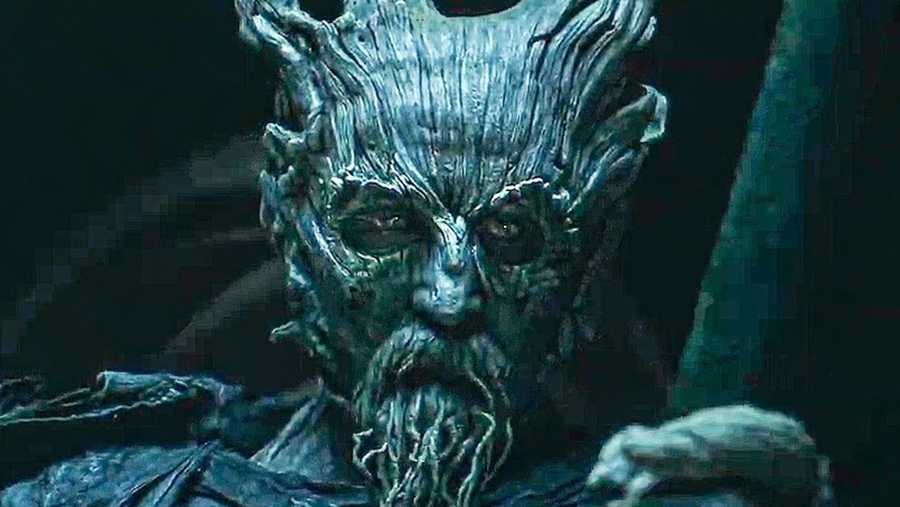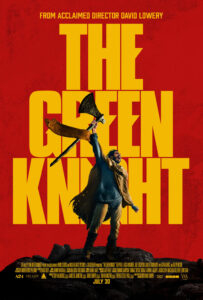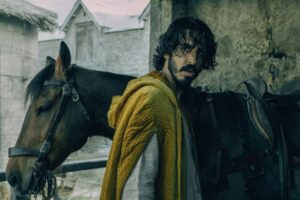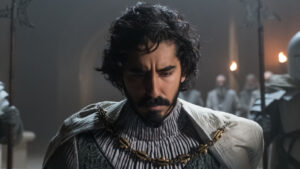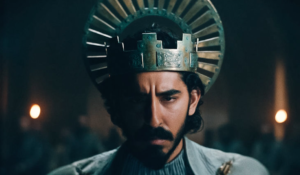Directed and Written by David Lowery | 130 min | Amazon Prime
Count on the American indie studio A24 to deliver a counter-programming punch to the summer movie slate, a psychedelic adaptation of the ancient poem Sir Gawain and The Green Knight from the filmmaker responsible for the unaccountably overrated A Ghost Story. Lowery also gave us Them Bodies Ain’t Saints and The Old Man & The Gun, so thematic or stylistic consistency isn’t in his bailiwick.
Everything about this is counterintuitive for a summer movie on the big screen — a deeply deliberate art house period movie eschewing anything approaching a rousing fantasy or historic epic, instead centred on a deeply flawed protagonist and his how-not-to heroic journey. Don’t believe anyone who describes The Green Knight as “romantic” or an “adventure”. While the film’s production design is A+, its commitment to the parable keeps it at arms length from real emotion. Or much resembling fun.
We meet the callow Gawain (Dev Patel) on Christmas morning after a night of partying with Essel (Alicia Vikander), but we also get a taste of his ambitions, to be a knight, to serve the King (Sean Harris, for once playing sympathetic), who is called Gawain’s uncle but is also heavily implicated as his illegitimate father.
Gawain’s mother (Sarita Choudhury) seems to be a witch, but her deeper intentions for her son remain opaque. At the Christmas feast at court, the Green Knight, who takes on the form of a plant elemental, interrupts the festivities with a game, a challenge — whomever may lay a blow on him will seek him out a year hence, giving him the opportunity to return the violence. Seems like a terrible deal, but Gawain, looking to earn his knightly stripes, beheads the woody stranger, only to have him ride off, laughing, a headless horseman.
A year later Gawain takes up the chainmail, sword, and shield, to ride six days north to fulfill his destiny. Here’s the meat of the second act, an episodic succession of challenges that Gawain mostly fails. He generally comes off as a schnook who likes to get slapped around.
People keep calling him a knight because he looks the part, but he’s not up to it. In no time he’s separated from his horse and the axe the Green Knight left him by scrappy thieves (led by Barry Keoghan, credited as The Scavenger), and when he meets a ghost looking for her head (Erin Kellyman, in one of the few, welcome moments of levity), he’s only barely able to help her.
Later on he meets a Lord (Joel Edgerton) who welcomes him in, but the Lady of the manor is a doppelgänger for Essel (Vikander again), which is confusing, as is a talking fox — more in the Lars von Trier stable of talking foxes than the Wes Anderson.
Along the way we get some of the most gorgeous cinematography (by Andrew Droz Palermo) I’ve seen in a fantasy film in yonks, accompanied by a stunning score (by Daniel Hart) and costumes to die for (by Malgosia Turzanska). This is full-on immersive filmmaking, where every shot and camera movement is art directed up the wazoo.
But, to what end? As the credits were rolling I was still wondering what the movie was all about.
Is it concerned with the folly of youth, the real-world consequences of violence or the pointlessness of chivalry? Is it about Paganism versus Christianity? Witness the late-arriving homage to The Last Temptation of Christ. It could be all these things, and more. This is a story where women stand to one side but make an impact through negotiation, manipulation, and magic. A post-credit sting suggests a different future, for what that’s worth. But, mostly, The Green Knight is confounding storytelling, offering up symbolism in the place of narrative. That’s a legit choice, but whether or not it makes for satisfying viewing — your mileage (on horseback) may vary.
There were two moments that made me feel something. The first is spectacular vision of naked giants striding through a misty valley. I wanted a movie all about them. The second is a monologue by Vikander describing the real value, the real meaning, of the colours green and red.
Otherwise, despite the visual and aural splendour, I was unmoved.





